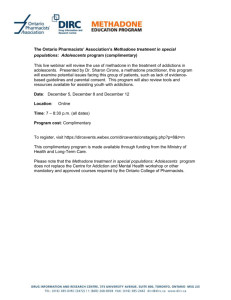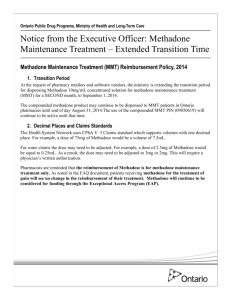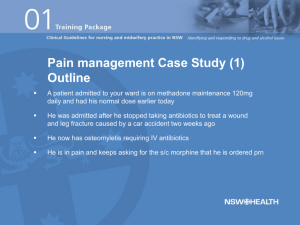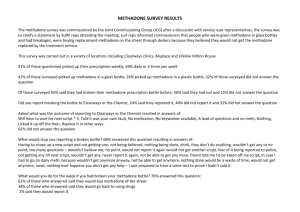Office-Based Opioid Therapy: Methadone/Buprenorphine Nexus
advertisement
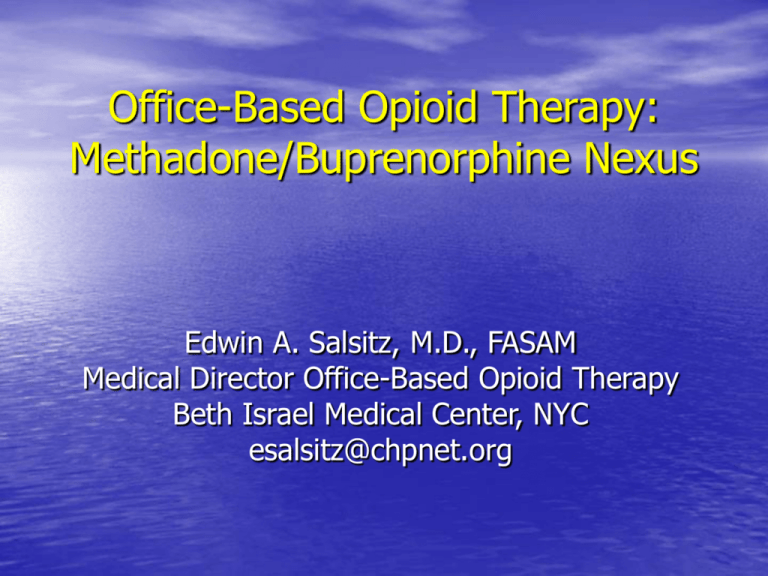
Office-Based Opioid Therapy: Methadone/Buprenorphine Nexus Edwin A. Salsitz, M.D., FASAM Medical Director Office-Based Opioid Therapy Beth Israel Medical Center, NYC esalsitz@chpnet.org Financial Disclosure • Reckitt Benckiser Speaker Honoraria • Pfizer Speaker Honoraria • PriCara Speaker Honoraria • Purdue Pharma Adv.Board Honoraria MEDICATION ASSISTED ADDICTION TREATMENT “All Treatments Work For Some People/Patients” “No One Treatment Works for All People/Patients” Alan I. Leshner, Ph.D Former Director NIDA OPIATE AGONIST THERAPY Addiction Regulatory Pharmacology Stigma Destitution Political The Lexington Narcotic Farm The first facility opened on May 25, 1935, outside Lexington, Ky. The 1,050acre site included a farm and dairy, working on which was considered therapeutic for patients. With the increased availability of state and local drug abuse treatment programs, the hospital was closed in February 1974. Drs. Kolb, Himmelsbach, Wikler, Jaffe, Kleber, Vaillant JAMA Classics: Celebrating 125 Years Methadone Maintenance 4 Decades Later Thousands of Lives Saved But Still Controversial Commentary by Herbert D. Kleber, MD JAMA. 2008;300(19):2303-2305 JAMA. 1965;193(8):646-650 Exclusion: non-opioid addiction/misuse, severe psychiatric problems Opiate Addiction Treatment Outcome* Methadone Maintenance 50 – 80% Naltrexone Maintenance 10 – 20% “Drug Free” (non-pharmacotherapeutic) LAAM Maintenance 5 – 30% 50 – 80% Buprenorphine-Naloxone Maintenance 40-50%** Short-term Detoxification (any mode) 5 – 20% (limited data) * One year retention in treatment and/or follow-up with significant reduction or elimination of illicit use of opiates ** Maximum effective dose (24mgsl) equal to 60 to 70 mg/d methadone. Data base on 6 month follow-up only. Kreek, 1996; 2001 Methadone • Synthetic Opioid 1937 Germany • T ½ 24—36 hrs. Inherent • Onset of Action 30 min. Peak 3-4 hrs. • R/S(l/d) racemic mixture mu/NMDA antag • CYP3A4, 2D6 Drug/Drug No Active Metab • Renal and biliary excretion • Dosing QD for addiction, Q6H for Pain Functional State (Heroin) Impact of Short-Acting Heroin versus Long-Acting Methadone Administered on a Chronic Basis in Humans - 1964 Study "High" "Straight" "Sick" AM PM AM PM AM PM AM Functional State (Methadone) Days "High" "Straight" "Sick" AM PM AM Days H Dole, Nyswander and Kreek, 1966 Acc VTA GLU FCX Amphetamine Cocaine Opiates Cannabinoids Phencyclidine Ketamine HIPP AMYG CRF GLU 5HT GABA OPIOID OPIOID GABA GABA DYN 5HT ENK VP OFT BNST Opiates DA GABA NE LC ABN HYPOTHAL ICSS MesoLimbic Dopaminergic Circuit Pleasure/Reward Center H2O, Food, Sex, Parenting, Social NE LAT-TEG Opiates Ethanol Barbiturates Benzodiazepines Nicotine Cannabinoids PAG END 5HT Raphé To dorsal horn RETIC Molecular and Cellular Basis of Addiction Science 3 October 1997: Eric J. Nestler, George K. Aghajanian Figure 2. Scheme illustrating opiate actions in the locus coeruleus. Opiates acutely inhibit locus coeruleus neurons by increasing the conductance of an inwardly rectifying K+ channel through coupling with subtypes of Gi/o, as well as by decreasing a Na+dependent inward current through coupling with Gi/o and the consequent inhibition of adenylyl cyclase. Reduced concentrations of cAMP decrease PKA activity and the phosphorylation of the responsible channel or pump. Inhibition of the cAMP pathway also decreases phosphorylation of numerous other proteins and thereby affects many additional processes in the neuron. For example, it reduces the phosphorylation state of CREB, which may initiate some of the longer-term changes in locus coeruleus function. Upward bold arrows summarize effects of chronic morphine administration in the locus coeruleus. Chronic morphine increases concentrations of types I and VIII adenylyl cyclase (AC I and VIII), PKA catalytic (C) and regulatory type II (RII) subunits, and several phosphoproteins, including CREB. These changes contribute to the altered phenotype of the drug-addicted state. For example, the intrinsic excitability of locus coeruleus neurons is increased by enhanced activity of the cAMP pathway and Na+dependent inward current, which contributes to the tolerance, dependence, and withdrawal exhibited by these neurons. Upregulation of type VIII adenylyl cyclase is mediated by CREB, whereas up-regulation of type I adenylyl cyclase and of the PKA 39 wk 39wk 137wk Cerebral phosphorus metabolite abnormalities in opiate-dependent polydrug abusers in methadone maintenance Psychiatry Research: Neuroimaging Volume 90, Issue 3 , 30 June 1999, Pages 143-152 Kaufman,M Phosphorous MR Spectroscopy Fig. 3. Metabolite levels in control subjects (n=16) and in short- (n=7) and long-term (n=8) methadone maintenance treatment (MMT) subgroups. Shown are means±S.D. of percent metabolite measures. Post hoc Scheffé test results: *P<0.05 vs. control subjects; **P<0.01 vs. control subjects; ***P<0.0001 vs. control subjects ;†P<0.05 vs. long-term MMT group From these data, we conclude that polydrug abusers in MMT have 31P-MRS results consistent with abnormal brain metabolism and phospholipid balance. The nearly normal metabolite profile in long-term MMT subjects suggests that prolonged MMT may be associated with improved neurochemistry. Psychiatry Research: Neuroimaging Volume 90, Issue 3 , 30 June 1999, Pages 143-152 Distribution of Opioid Treatment Programs (OTPs) 2002 SAMHSA/CSAT 581 Male Heroin Addicts Followed for 33yrs The natural history of narcotics addiction among a male sample (N = 581). From: Yih-Ing, et. al., 2001. A 33-Year Follow-up of Narcotics Addicts. Archives of General Psychiatry, 58:503-508) Medical Maintenance Admission Criteria • At least 4 years in MMTP • Negative urines for last 3 years • Working/School etc. • Adequate income for fees • Recommendation from clinic • Not in military reserves • Stable and safe storage environment Medical Maintenance Procedures • Patient given 28 day supply of methadone, by MD,in disket form, every 4 weeks. • Medication prepared by hospital pharmacy in usual Rx type bottle and label • Routine urine toxicologies • Patient returns before “run out” date • Primary care provided Methadone Maintenance Total duration in years N = 233 patients 60 50 40 30 No of patients 20 10 0 0-5 6-10 11-15 16-20 21-25 26-30 31-35 36-40 4/05 Duration in years Medical Maintenance Total Duration in Years N= 233 patients 100 90 80 70 60 50 40 30 20 10 0 No. of patients 0-5 6-10 11-15 Duration in years 16-20 4/05 Medical Maintenance--Dosage • Average = 75mg./day • Median = 80mg./day • Range = 5mg.----200mg./day • 30% Split Dose 04/05 N=223 Medical Maintenance 1983 - Present 347 =Total Enrolled Withdrew 22 (6%) TransferMMTP 7 Pain 9 Revised –06/16/09 MMTP 41(12%) Cocaine 19 Cause 22 Deaths 59 (17%) 23 14 4 9 4 1 2 1 1 - Tobacco - Hepatitis C - Lymphoma - Medical - HIV -Old Age -Homi/Suicide -Prostate Ca Leukemia Active 184 (53%) Buprenorphine 24 Deaths: 1 Tob 1 Hep C 9 liver transplants 8 patients 4 alive Prevalence of HIV-1 (AIDS Virus) Infection in Intravenous Drug Users New York City: 1983 - 1984 Study: Protective Effect of Methadone Maintenance Treatment 50 – 60% 9% Untreated, street heroin addicts: Positive for HIV-1 antibody Methadone maintained since<1978 (beginning of AIDS epidemic): less than 10% positive for HIV-1 antibody Kreek , 1984; Des Jarlais et al., 1984; 1989 New York Times Dry Mouth Decay, Crave Sugary Drinks, Brushing/Flossing, Caustic Ingredients Grinding/Clenching Teeth, STIGMA--METHADONE • “My Wife’s Opinion Is That Methadone Maintenance Treatment Is As Close To Evil As You Can Get, Without Killing Someone.” A “successful” methadone patient quoting his wife’s attitude toward methadone treatment U.S. Drug Enforcement Administrative Agent Joanne Masur, one of the last government witnesses in the case against Shinderman, took the stand Friday in U.S. District Court in Portland. Masur, whose job is preventing the diversion of prescription drugs to the black market, said she consulted with Shinderman on at least two occasions. But she said she had no bias against him or his clients, although she said she may have referred to them as "dirt bags." "That is a term I use," she said. "But it's not necessarily derogatory." Portland Press Herald, 7/15/06 Crane collapses in busy New York street, killing seven in worst construction accident in recent memory' SUBSTITUTION TREATMENT ??????? Helpful/Harmful “Substituting one addiction for another” 3/19/08 Critics say methadone simply replaces one dependency with another, and some say methadone can be even harder to quit than heroin. Scottish Conservative Party justice spokesman, Bill Aitken, recently described many of those in methadone programmes in Scotland as “sitting fat, dumb and happy" on the drug. Percent Change in Distribution of Methadone and Three Comparison Drugs, 1998--2002 Methadone Oxycodone Morphine Hydrocodone Percent Change from Baseline Year 1998 300% 250% 200% 150% 100% 50% 0% 1999 2000 2001 2002 Center for Substance Abuse Treatment, Methadone-Associated Mortality: Report of a National Assessment, May 8-9, 2003. SAMHSA Publication No. 04-3904. Rockville, MD: Center for Substance Abuse Treatment, SAMHSA, 2004. 54% 390% Methadone Deaths Not Linked to Misuse of Methadone from Treatment Centers • The consensus report, “Methadone-Associated Mortality, Report of a National Assessment”, concludes that “although the data remain incomplete, National Assessment meeting participants concurred that methadone tablets and/or diskettes distributed through channels other than opioid treatment programs most likely are the central factor in methadone-associated mortality.” • The panel based it conclusion that methadone is coming from other sources on data showing that the greatest growth in methadone distribution in recent years is associated with its use as a prescription analgesic prescribed for pain, primarily in solid tablet or diskette form, and not in the liquid formulations that are the mainstay of opioid treatment programs that treat patients with methadone for abuse of heroin or prescription pain killers. • The experts surmise that current reports of methadone deaths involve one of three scenarios: illicitly obtained methadone used in excessive or repetitive doses in an attempt to achieve euphoric effects; methadone, either licitly or illicitly obtained, used in combination with other prescription medications, such as benzodiazepines (anti-anxiety medications), alcohol or other opioids; or an accumulation of methadone to harmful serum levels in the first few days of treatment for addiction or pain, before tolerance is developed SAMHSA--2004 JAMA 2000:283:1303-1310 Survival Function by Treatment Group Sees, K. L. et al. JAMA 2000;283:1303-1310. Copyright restrictions may apply. Proportion of Participants Using Heroin and Mean Days of Heroin Use in Previous 30 Days Sees, K. L. et al. JAMA 2000;283:1303-1310. Copyright restrictions may apply. Remaining in treatment (nr) Buprenorphine Maintenance/Withdrawal: Retention 20 15 10 Control 5 Buprenorphine 0 0 50 100 150 200 250 Treatment duration (days) 300 350 (Kakko et al., 2003) Kakko et al, Lancet Feb 22, 2003 Buprenorphine Maintenance/Withdrawal: Mortality Placebo Dead 4/20 (20%) Buprenorphine Cox regression 2=5.9; 0/20 (0%) p=0.015 Transitioning Stable Methadone Maintenance Patients to Buprenorphine Maintenance Edwin A. Salsitz, M.D., FASAM Beth Israel Medical Center New York City Why Transition From Methadone? • • • • • Office-based availability Less than monthly visits Different side effect profile Possible diminished stigma Geographic Flexibility Why Not Transition? • May not be as effective for individual • Fear of destabilization • Transition difficult – Opioid withdrawal required – May precipitate withdrawal • • • • Less social and psychological services Insurance/cost Satisfied with methadone “If it Ain’t Broke….” Subjects • MMM eligibility requirements – 4 years in Methadone Maintenance Treatment Program (MMTP) – 3 years of illicit drug abstinence – No excessive drinking – Employment/Education, etc. – Emotional stability • 6/03 - 1/08 patients on methadone ≤ 80 mg/day offered transition to buprenorphine Johnson RE, Chutuape MA, et al. A comparison of levomethadyl acetate, buprenorphine, and methadone for opioid dependence. N Engl J Med. 2000;343:1290– 1297. Transfer • Patients given option to taper methadone to 30-40 mg/day • Standard protocol used – Patients abstained from methadone for 48-72 hours – First buprenorphine/naloxone dose given when Clinical Opiate Withdrawal Scale (COWS) score indicated withdrawal • Stabilized over following week Center for Substance Abuse Treatment. Clinical guidelines for the use of buprenorphine in the treatment of opioid addiction. Treatment Improvement Protocol Series (TIPS) 40. Department of Health and Human Services Publication #SMA04-3939. Rockville, MD: Substance Abuse and Mental Health Services Administration, 2004. Study Participants • 102 MMM patients offered buprenorphine • 23 (22.5%) accepted • Two stable MMTP patients referred • 104 patients total-25 (24.0%) accepted • Reasons for not wanting to switch – no perceived advantage of switching – concern about efficacy – concern about side effects (withdrawal) Outcomes • 25/25 patients successfully stabilized on buprenorphine (100%) • Average buprenorphine dose- 10.9 mg (S.D. 7.6) • Average time on buprenorphine maintenance- 30.3 months (S.D. 16.5) Final buprenorphine dose mg/day Methadone Dose Compared to Buprenorphine Dose 40 35 30 25 20 15 10 5 0 0 10 20 30 40 50 60 70 80 90 Baseline methadone dose mg/day Low-moderate correlation - Spearman rank order coefficient = 0.46, p = 0.02 Positive Experiences • No stabilized subjects elected to return to methadone • Less frequent office visits – every 1 - 6 months, not monthly – several patients moved further away from program • 24/25 patients reported feeling “clearer” Unsuccessful Transfers • 5 initially reluctant patients agreed to attempt conversion • All unsuccessful • Duration of buprenorphine treatment - 1 dose to 5 days • Returned to methadone without event • 2 cases - “dysphoria” • 3 cases – no reason listed Study Strengths • Subjects – Unique population in research – Findings applicable to stable methadone maintained patients seeking transfer to Buprenorphine • Very long follow-up period - absence of negative outcomes CONCLUSIONS • Buprenorphine is viable maintenance treatment for stable patients on methadone doses up to 80 mg/day • Transitioning generally well tolerated • Buprenorphine efficacious and safe long-term • Low to moderate association between methadone and buprenorphine doses Admission EKG QTc~ 600 msec. QTc ~ 440 msec. Bupe started Off methadone x 1 Week Russia Scorns Methadone for Heroin Addiction Science Times 7-22-08, Michael Schwartz • After the conference in February, which Dr. Mendelevich • • helped organize, Moscow’s legislature began an inquiry into whether he had engaged in “drug propaganda,” and it called on prosecutors to open a case against him, he said At the same AIDS conference, Dr. Gennady G. Onishchenko, the country’s chief sanitary doctor, the equivalent of surgeon general, said health officials “are not convinced that this is effective,” and added, “There is little optimism for legalizing methadone therapy in the near future.” “Scientific arguments, evidence-based data, are not convincing them,” said Evgeny M. Krupitsky, the head of a laboratory that conducts research on drug addiction at St. Petersburg State Pavlov Medical University. Russian methodology regarding opiate addiction “is not evidencebased,” but relies on “subjective opinions of major leaders in this field. DRUG PROBLEM Patients in a program for heroin addiction in Yekaterinburg, Russia, run by a nongovernmental group. MEDICATION ASSISTED ADDICTION TREATMENT “All Treatments Work For Some People/Patients” “No One Treatment Works for All People/Patients” Alan I. Leshner, Ph.D Former Director NIDA
